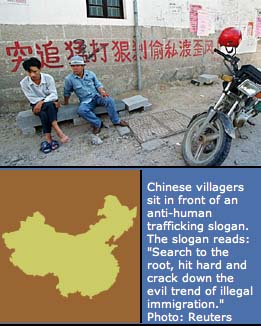Smuggled migrants become victims when trapped into force labor to repay traffickers.
Type: Source, Transit, and Destination Country
Background
In the past decade tragic stories about Chinese immigrants have made headlines around the world. In the U.S., 10 Chinese immigrants died trying to swim to shore when the Golden Venture, a ship carrying nearly 300 immigrants from southern China, ran aground off Rockaway, New York, in 1993. A Hong Kong-based human rights group estimates that half a million Chinese attempted or succeeded in illegally leaving the country in 1999 alone. Chinese organized criminal gangs such as the snakeheads operate worldwide, facilitating human smuggling and trafficking out of China. The International Organization for Migration reports that organized crime rings smuggle up to 200,000 Chinese migrants into Australia, Canada, the U.S., and other countries each year.
Victims
Chinese women and children are trafficked for sexual exploitation to North America, Europe, and other Asian countries. In the U.S. several women working for an international ring — reportedly responsible for trafficking as many as 100 victims a month — were arrested in Houston, Texas, for transporting Chinese women into the country for prostitution. Los Angeles and New York are other common destination cities. In 1999, the Immigration and Nationalization Service estimated that up to 5,000 trafficked Chinese women were in L.A.
Many internationally trafficked Chinese men and women are also subjected to forced labor worldwide. They typically work in sweatshops or restaurants in slave-like conditions in order to pay off debts to smugglers.
Internal trafficking also takes place in China. Abducted women are taken to provinces far away from their homes and sold to men who have trouble finding local women to marry. A Chinese human rights NGO estimates the number of women sold as brides to be more than 50,000. In one documented case, a wife and mother of two, while traveling for work, was drugged and eventually sold as a bride for $1,500. The gender imbalance in China is a major reason for trafficking of women into forced marriages. After China adopted the one-child policy in 1979, the number of females dropped because of selective abortion or infanticide. In parts of rural China, males outnumber females by 20 to 40 percent.
China is a destination country for trafficked women from Vietnam. Since China and Vietnam have restored diplomatic relations, about 10,400 Vietnamese women have been sold in China for prostitution or as brides for Chinese men. Last year Chinese police rescued two Vietnamese women and turned them over to their country’s authorities. The traffickers were later sentenced to jail for between four and 17 years.
Counter-Trafficking Efforts
Although China does not fully comply with the minimum international standards to eliminate trafficking, the State Department, in its 2003 Trafficking in Persons report, acknowledges China’s significant efforts to do so. China is proactive on two fronts: prevention and prosecution. In 2002 China, along with UNICEF, began a national plan called Elimination of Trafficking: Zero Tolerance Plan. Its goal is to bring awareness to rural farmers and to end the practice of selling women and children. The International Labor Organization also sponsors a multimillion dollar anti-trafficking and prevention program in China’s Yunan province. The province is part of the Mekong subregion that includes Cambodia, Thailand, and Vietnam — an area with high human trafficking activities.
The Chinese government views human trafficking as a priority law enforcement issue and has an anti-trafficking unit within the Ministry of Public Security. In a six-month crackdown in 2000 the police arrested thousands of traffickers, which resulted in hundreds of executions. Law enforcement officials cooperate with their counterparts in Vietnam and Thailand in trafficking cases.



